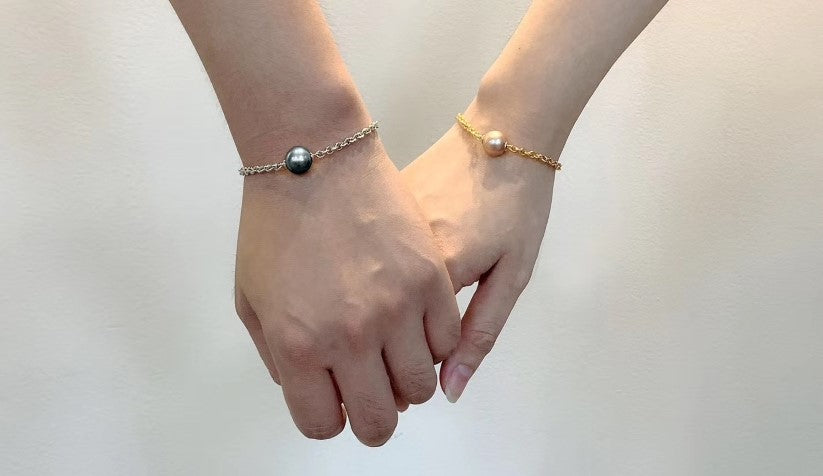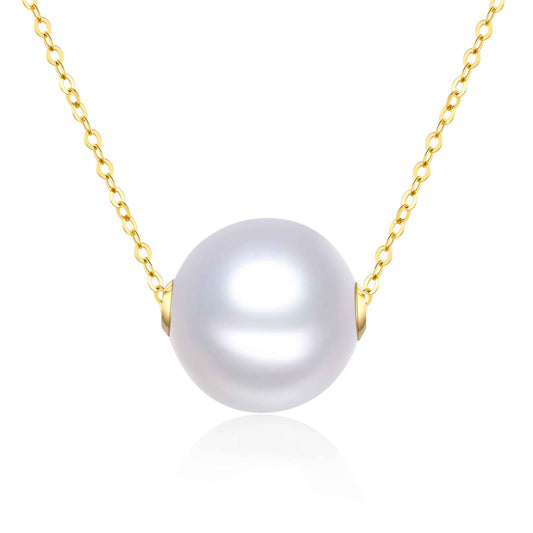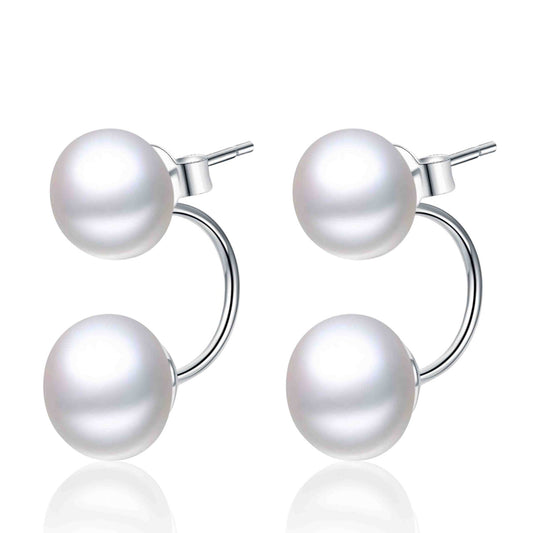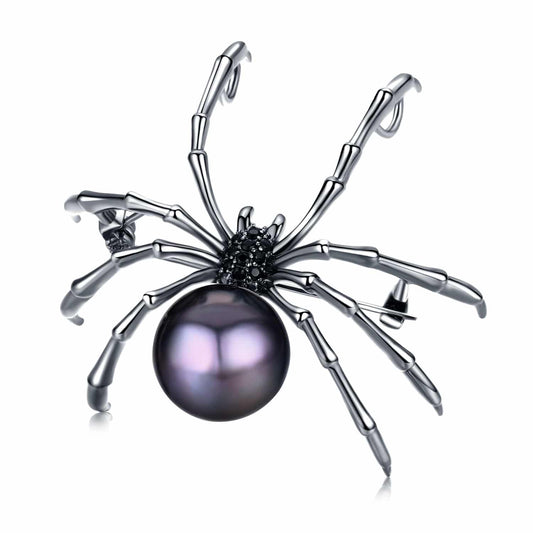
South Sea vs. Tahitian Pearls: What’s the Difference and Why It Matters
Share
Some jewelry turns heads. Pearls don’t clamor for attention. They wait. They glow. And somehow, they stay with us through generations. There’s a stillness to them, something pleasant, kind of sacred. Unlike other jewelry, pearls seem to hold time within them. They don’t sparkle loudly. They don’t rush. They simply are. And in that stillness, we find something certain, something lasting.
When we think about our most cherished pieces, the ones passed down or chosen to mark a turning point, it’s often pearls that come to mind. And here we are bringing you the tale of two iconic pearls, two that stand out: Tahitian pearls and South Sea pearls. They don’t just differ in appearance. They carry different energies. Different moods. Even different stories.
What makes one pearl feel bold, while another leans toward softness? Why does one seem modern and moody, the other timeless and luminous? The answers are layered, like the nacre itself. So if you’re deciding between the two, or just learning the language of fine pearls, we’re here to walk you through it, not with facts alone, but with feelings too.
The Origins: Where Tahitian & South Sea Pearls Begin Their Journey
Before coming into its charm, pearls hold a secret life inside the deep blue oceans. Each stage of its existence, whether in the fathomless depths of the ocean or cradled in an oyster’s shell, unfolds a distinct story, taking on a new form every time. You can feel that story the moment you hold one.
Tahitian pearls form in the warm, glass‑calm lagoons of French Polynesia. Small crews tend floating lines of black‑lipped Pinctada margaritifera oysters, letting water, light, and minerals work slowly. Years later, the harvest glows in smoky greens, silvers, violets, and jet blacks, colors born of both species and environment.
South Sea pearls begin farther offshore, in the open waters of northern Australia, Indonesia, and the Philippines. Here, the larger white‑ or gold‑lipped Pinctada maxima thrives in clear, moving seas. Its pearls grow bigger and paler, creamy whites to deep golds, with a satiny inner radiance that contrasts with the sharper luster of Tahitians.
What both varieties share is time. Each gem carries years of quiet watchfulness, lines reset, shells checked, tides studied, labor you’ll never see in the finished pearl, yet it pulses beneath every shimmer.
Color & Luster: How to Spot the Difference at First Glance
When you open a box with Tahitian pearls inside, your eyes might pause. They're not actually black, though people often call them that. They're more like dark peacock, slate gray, storm blue, sometimes a mix of all three. They carry a metallic sheen. A little moody. A little mysterious but beautiful.
We love them for the depth they hold. You’ll find that no two are exactly the same. And that’s part of their beauty.
South Sea pearls feel like a different world. These are the ones you imagine on a classic bride, or a quiet luxury necklace, and that's why they are called ‘queen of pearls’. Their colors range from creamy white to champagne to deep gold. The golden ones, especially, have a soft kind of warmth. Not flashy. Just glowing. The light they reflect is diffused; they are more like candlelight than a mirror.
Tahitian pearls command attention, catching every eye. South Sea pearls, by contrast, lie softly against the skin, drawing the quiet appreciation you truly deserve. The distinction is subtle yet unmistakable; you feel it the moment you wear them.
Size, Shape & Surface: Understanding Their Natural Beauty
South Sea pearls are known for their size. They’re some of the largest cultured pearls in the world, often measuring over 13mm, and sometimes as much as 18mm. That kind of size doesn’t happen quickly. It takes time, the right oyster, and excellent water conditions. The result is a pearl that feels substantial. Heavy in a way that says luxury.
Tahitian pearls, while slightly smaller (typically 8mm–14mm), offer more variety in shape. You’ll see perfect rounds, but also ovals, drops, and even abstract baroque shapes. We’ve always found that shape variety adds character. Not every pearl needs to be symmetrical to be stunning.
You’ll also notice that neither type is flawless. And that’s the best thing. Tiny ripples, soft dents, surface textures, each has its uniqueness; these are part of how nature leaves its mark. In high-quality pearls, imperfections are minimal and usually well-placed. But even when they show, they show the truth. Real pearls aren’t manufactured. That’s what makes them special.
Price & Value: What Makes Each Pearl an Investment

A lot of people ask us which type of pearl is “more valuable.” Well, the answer depends on how you define value.
South Sea pearls, generally speaking, cost more. They're larger, harder to produce, gently curated within the lap of deep blue oceans, and cultivated in fewer places. Their soft radiance and classic style also make them a top choice for heirloom jewelry and collector’s pieces.
Tahitian pearls are priced more accessibly, well, that doesn’t mean they’re any less worthy. Their unique, dark coloring is 100% natural, adding value to their existence with no dye, no enhancement. That alone makes them rare in their own category. If you're drawn to jewelry that starts a conversation, Tahitian pearls tend to do that effortlessly.
Styling Tips: How We Wear & Pair These Pearls

Jewelry choices say a lot. So does timing.
Tahitian pearls are the go‑to when you crave a touch of drama. Picture a bold pendant at a twilight gala or drop earrings that frame the face with an unexpected gleam. They complement black and navy, elevate silk blouses, and add edge to leather jackets, always chic, never overdone. And because their appeal is gender‑neutral, you’ll increasingly find Tahitian pearls on men’s cuffs, tie pins, and necklaces, proving style knows no boundaries.
South Sea pearls skew refined and understated, yet they’re surprisingly versatile. We’ve paired them with bridal gowns as easily as with denim and a crisp white shirt; their quiet elegance always feels right. No special occasion required. Layer them with slim gold chains, petite diamond stations, or bursts of colored gemstones. And don’t hesitate to mingle South Sea and Tahitian strands; contrasting lustres often create the most compelling look.
Begin Your Pearl Story with Us
At Timeless Pearl, there’s a strand, or a single luminous gem, waiting to mirror your own brilliance.
Mark a milestone, surprise someone special, or simply treat yourself with a piece that will carry today’s story into tomorrow. Whether you lean toward the dramatic glow of Tahitian pearls or the quiet radiance of South Sea pearls, you deserve a treasure that lasts.
Explore our collections and find your pearl now.






